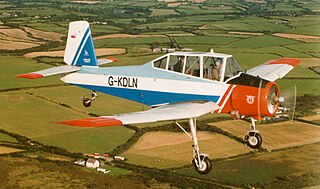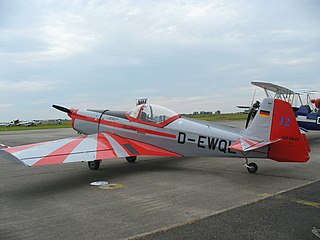Related Research Articles

The Bowers Fly Baby is a homebuilt, single-seat, open-cockpit, wood and fabric low-wing monoplane that was designed by famed United States aircraft designer and Boeing historian, Peter M. Bowers.

The PZL-Mielec M-18 Dromader is a single engine agricultural aircraft that is manufactured by PZL-Mielec in Poland. The aircraft is used mainly as a cropduster or firefighting machine.

The Cessna 425, known as the Corsair and later as the Conquest I, is an eight-seat American pressurized turboprop twin-engined light aircraft. Now out of production, it was built by Cessna Aircraft of Wichita, Kansas, between 1980 and 1986.

The Harbin Y-11 is a high wing twin-engine piston utility and geological survey aircraft built by Harbin Aircraft Manufacturing Corporation (HAMC).

The Valmet PIK-23 Towmaster or Suhinu is a Finnish two-seater glider-towing/primary trainer aircraft built entirely out of composite materials in the early 1980s.

The Zlin Z-37 Čmelák, also known as LET Z-37 Čmelák is an agricultural aircraft which was manufactured in Czechoslovakia. It is powered by a Soviet-built Ivchenko reciprocating engine. The aircraft is used mainly as a cropduster.

The Bölkow Bo 207 was a four-seat light aircraft built in West Germany in the early 1960s, a development of the Klemm Kl 107 built during World War II.

The Isaacs Spitfire is a single seat homebuilt sporting aircraft design created by John O. Isaacs, a former Supermarine employee and retired schoolmaster and designer of the Isaacs Fury, as a 6/10th scale replica of a Supermarine Spitfire. Its first flight was on 5 May 1975.

The Brügger MB-1, MB-2 and MB-3 Colibri is a family of small sports aircraft designed in Switzerland in the 1960s and 1970s for amateur construction.

The Zlin Z-526 Akrobat is a Czech sports plane used in aerobatics.
The Civil Aviation Department Revathi was a light utility aircraft designed in India principally for use by that country's flying clubs.
The Davis DA-5, a.k.a. DA-5A, is a single-seat sport aircraft designed in the United States in the 1970s and marketed for homebuilding. Like designer Leeon D. Davis's successful DA-2, it is a low-wing monoplane with fixed tricycle undercarriage and a V-tail, but with a much narrower fuselage accommodating only the pilot, and a lengthened nose. Design work was carried out in 1972, but the prototype was not built until 1974, when it was completed in only 67 days.
The Frederick-Ames EOS/SFA was a single-seat sports aircraft designed in the United States in the 1970s with the intention of marketing it for homebuilding. It was a highly streamlined low-wing cantilever monoplane with swept flying surfaces and retractable tricycle undercarriage. Its construction was of metal throughout.
The Gatard Statoplan AG 02 Poussin was a light, single-seat sports airplane developed in France in the late 1950s and marketed for homebuilding. In layout, it was a low-wing cantilever monoplane of short-coupled design with fixed tailwheel undercarriage. Construction was a plywood-covered wooden structure throughout, and the cockpit was enclosed by a large perspex bubble canopy. The variable-incidence horizontal stabiliser was fitted with small endplates to provide extra directional stability but there were no separate elevators.

The Jeffair Barracuda is a high-performance sporting monoplane that was developed in the United States in the 1970s and is marketed for homebuilding. Designed and built by Geoffrey Siers, the prototype won the prize for "Most Outstanding New Design" at the EAA Fly-in in 1976. It was a low-wing cantilever monoplane of wooden construction with retractable tricycle undercarriage and side-by-side seating for two. Around 150 sets of plans had sold by 1977.
The THK-5 was a twin-engine aircraft designed by Stanisław Rogalski and built in Turkey in 1945 as an air ambulance. It was a conventional, low-wing cantilever monoplane of wooden construction throughout. The main units of the tailwheel undercarriage retracted into the wing-mounted engine nacelles and the THK-5 could carry two stretcher cases plus a medical attendant. This was followed in production by a six-seat utility transport version designated THK-5A and three examples of an improved version of the 5A designated THK-10. A single example of the type was exported, sold to Denmark.

The Wassmer WA-80 Piranha is a French two-seat low-wing cabin monoplane trainer designed and built by Société Wassmer. Based on the same construction as the company's WA-50 four-seater, the WA-80 was a scaled down version. The prototype, registered F-WVKR, first flew in November 1975 powered by a 100 hp Rolls-Royce Continental O-200 engine. Wassmer appointed a receiver and suspended production in 1977 after 25 had been built.
The Practavia Sprite is a British two-seat homebuilt training or touring monoplane designed for amateur construction. It was the winning entry in a competition sponsored by Pilot magazine in 1968. The design had been begun as a magazine-sponsored project by Peter Garrison, who worked for Pilot at the time; when the project did not move forward rapidly enough to suit him, he returned to the United States, where he modified his design into what would become his first Melmoth.

The Piel CP.80 Zephir , Piel CP.801 and Piel CP.802 are racing aircraft developed in France in the 1970s and marketed for homebuilding. They are compact, single-seat, single-engine monoplanes with low, cantilever wings.

The PIK-15 Hinu is a light aircraft developed in Finland in the 1960s for use as a glider tug. It was a low-wing cantilever monoplane of conventional design with an enclosed cockpit and fixed, tailwheel undercarriage. The cockpit had two seats, side-by-side, and the PIK-15 was intended to have a secondary role as a trainer. Construction was of wood throughout.
References
- ↑ Federal Aviation Administration (25 November 2022). "Make / Model Inquiry" . Retrieved 25 November 2022.
- ↑ Taylor 1976, p. 502.
- Taylor, John W. R. (1976). Jane's All The World's Aircraft 1976–77. London: Jane's Yearbooks. ISBN 0-354-00538-3.
- Taylor, Michael J. H. (1989). Jane's Encyclopedia of Aviation. London: Studio Editions. p. 194.
- "Pete Bowers" Wind in the Wires Vol XIV No 10
- aerofiles.com